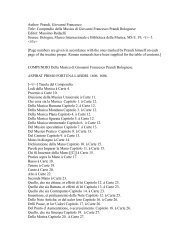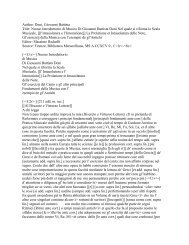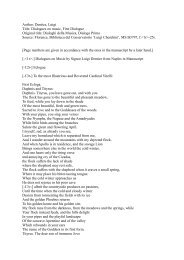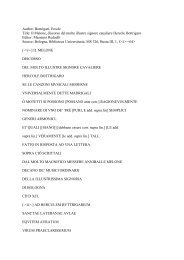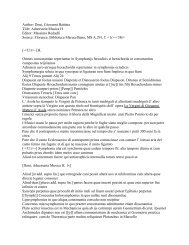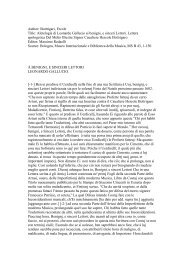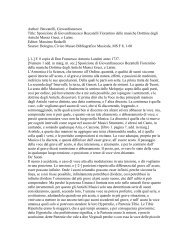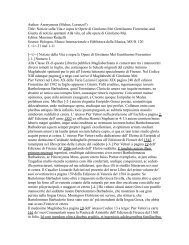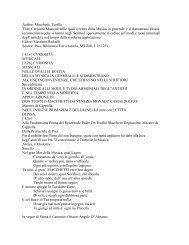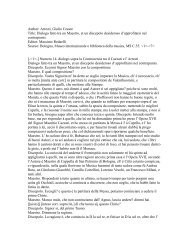Author: Doni, Giovanni Battista - manuscripts of italian music theory ...
Author: Doni, Giovanni Battista - manuscripts of italian music theory ...
Author: Doni, Giovanni Battista - manuscripts of italian music theory ...
You also want an ePaper? Increase the reach of your titles
YUMPU automatically turns print PDFs into web optimized ePapers that Google loves.
further on. I leave aside the Prisma, stenoprisma and ectome, which are even smaller<br />
intervals introduced by Mondoreo, a most erudite philosopher and great imitator [-<br />
-] <strong>of</strong> the ancients, because I do not know what use one might derive <strong>of</strong> it. [[But]]<br />
I cannot pass under silence the mistake that Glareanus, a man very erudite for his<br />
time, committed when he wanted that one should count two Diaschisma in the<br />
[[Tetrachord]] Enharmonic genus, rather than two Dieses. However one should<br />
forgive him because, having [[little familiarity with the ancient Greek <strong>music</strong>ians]]<br />
known almost only Boethius among the ancient <strong>music</strong>al writers, he understood as<br />
diesis, as the Pythagoreans [, especially the most ancient,] [Chalcidius in the<br />
Commentary on Plato's Timaeus in marg.] did, the smaller Semitone and more readily<br />
the limma [(as it was called theoretically) in marg.] which, together with two larger<br />
tones, constitutes the Diatessaron. I am much more surprised about Salinas [second<br />
book, chapter 13 in marg.], who is much more speculative than Glareanus, since he<br />
dared to reprehend Ptolemy, as if he believed that the comma was indistinguishable,<br />
when he says that it mattered little (talking about the practice <strong>of</strong> the instrumental<br />
ensembles <strong>of</strong> his time, rather than <strong>of</strong> Theory) to put two larger Tones or a larger and a<br />
smaller one. In fact, Ptolemy was not so dim [[that not]] that he considered the<br />
comma as an indistinguishable interval, but only wanted that whether the citharoedes<br />
tune the tetrachord in the Syntonic species [[or]] which [[can]] [contains corr. supra<br />
lin.] two larger tones, one larger and one smaller and a larger semitone, and in the<br />
diatonic species two larger tones and a limma, makes little difference in practice. [-<br />
-] It does not seem right to me that Zarlino should reprehend Aristotle because<br />
he said that the Diesis is a common measure <strong>of</strong> the interval or consonances, as if he<br />
intended instead that the consonances derive from the union <strong>of</strong> small intervals, rather<br />
than these are derived from the subdivision <strong>of</strong> those, as Zarlino maintains with reason,<br />
since one thing is to say that the Diesis is a common measure <strong>of</strong> the intervals, and<br />
something else that they are composed by it, in the same way that it would not follow<br />
that the palm is composed <strong>of</strong> the measures <strong>of</strong> a finger from saying that the finger or<br />
ounce is the common measure <strong>of</strong> the palm, the foot and the step, since it is possible<br />
that the measure <strong>of</strong> the palm is older than the one <strong>of</strong> the finger. [Nevertheless add.<br />
supra lin.], nothing, which is older is composed [composing ante corr. ]or is born<br />
[being born ante corr.] from a more recent one. It is also not credible that Aristotle<br />
learned this doctrine and Axiom from Aristoxenus who was a pupil <strong>of</strong> his (as<br />
[[maintains the same]] it seems to Zarlino himself), but, rather, that he learned this<br />
from older theorists. However, do let us see how they understood this participation [or<br />
conjunction add. supra lin.] <strong>of</strong> the Diesis in all the Intervals. Premised that they did<br />
not ignore that property <strong>of</strong> the proportions and consonances not to be able to be<br />
divided by the repeated octaves [--] into equal parts, I say nevertheless that they<br />
introduced with reason this common measurement [[firstly]] because they could see<br />
easily a line proportionately as a string <strong>of</strong> a lute is divided into six Tones, twelve<br />
semitones and twenty-four diesis, which, if they were equal as to the sound, and not to<br />
the string, as Valgulio thought too naively, the consonances are so little changed from<br />
their being that one can hardly noticed, but, with the help <strong>of</strong> the Canon the frets are<br />
located in the true and proper places which create unequal intervals and the right<br />
proportions, they vary in position so little that [[also diffic]] not for this one has to<br />
deem useless this common measurement, since it can be useful in many things, and,<br />
among others, to [[thus]] refine, so to speak, the tuning allowing the good ear <strong>of</strong> the<br />
<strong>music</strong>ian to provide them with that completeness which they receive, as we see in the<br />
viol, whose strings, like those <strong>of</strong> the lute, are mostly in fourths, like those <strong>of</strong> the lute.<br />
These are normally tuned perfectly, so that the fourths which are side by side are



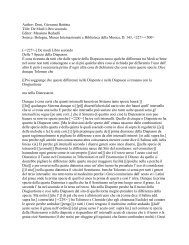
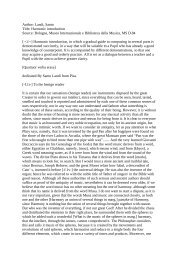
![Doni, Giovanni Battista Title: Trattato Dei Tuoni o [[Harmonie de]]](https://img.yumpu.com/45461005/1/190x245/doni-giovanni-battista-title-trattato-dei-tuoni-o-harmonie-de.jpg?quality=85)
